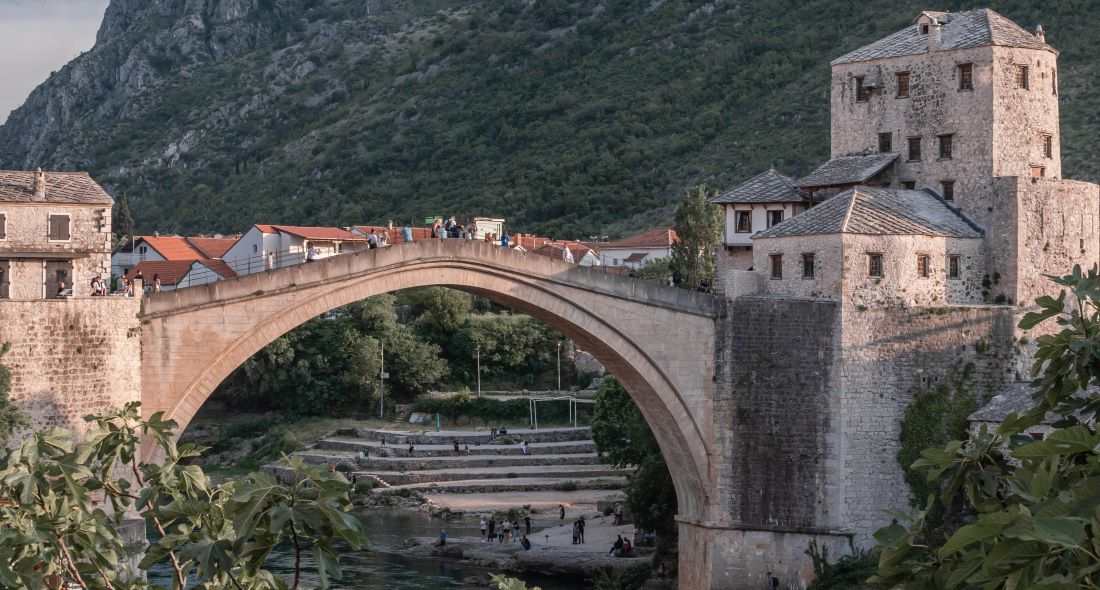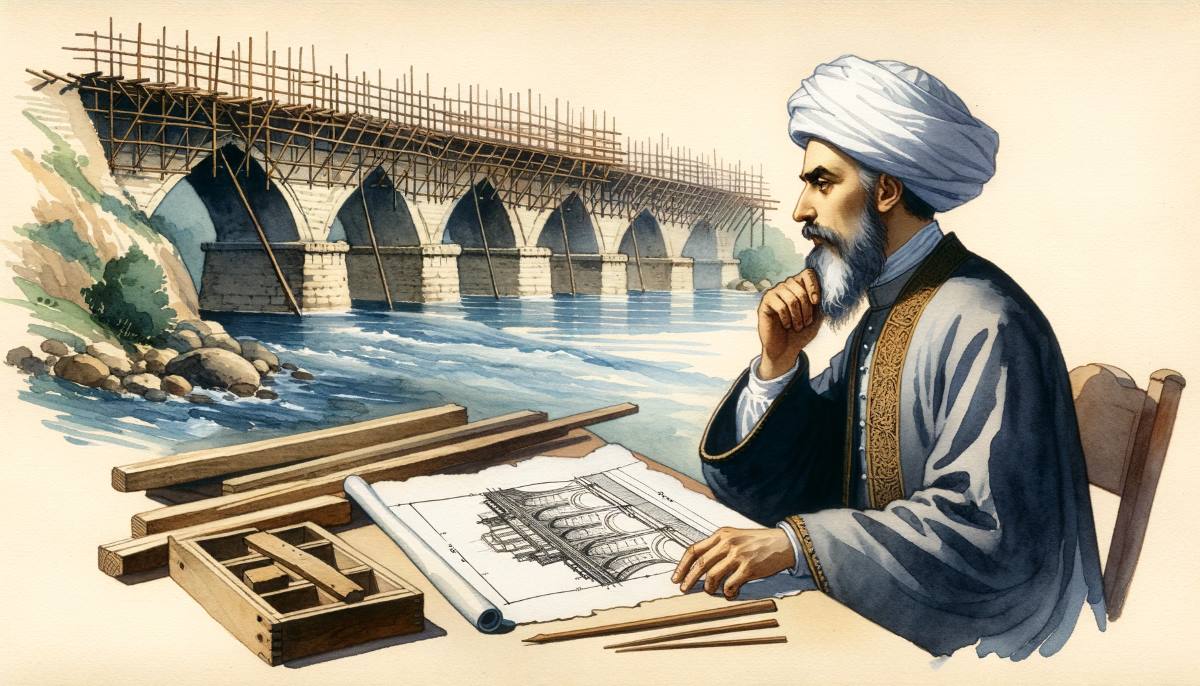Ottoman bridges in Bosnia and Herzegovina are a historical and cultural legacy, reflecting the centuries-long dominance of the Ottoman Empire in this region. These architectural gems not only connect riverbanks but also cultures, traditions, and histories. As you walk across them, you step through centuries of history and feel the breath of bygone times. Indeed, the Ottoman bridges stand as witnesses of endurance and change, symbolizing the bridge between Bosnia and Herzegovina’s past and present.
Ottoman Bridge Building and Renowned Architects
The era of the Ottoman Empire marked a period of architectural renaissance, with bridge construction being one of its many triumphs. Bridging vast expanses and treacherous terrains, these structures were more than mere connectors of land; they were symbols of the empire’s prowess, unity, and technological advancement. Ottoman bridges, characterized by their arched design, robust construction, and aesthetic appeal, played a pivotal role in improving trade routes, and military maneuvers, and fostering interregional connectivity. Often built using local materials and techniques, these bridges stood as an amalgamation of both Ottoman and local architectural styles, seamlessly blending into the landscapes they spanned.
One cannot discuss Ottoman bridge architecture without mentioning the masterminds behind these iconic structures. One of the most celebrated Ottoman architects was Mimar Sinan, the chief architect under Sultan Suleiman the Magnificent. Sinan’s genius lay in harmonizing function and aesthetics, creating bridges that were not only robust but also visually pleasing. Another prominent name is Mimar Hayruddin, the apprentice of Sinan, credited with the design of the iconic Old Bridge (Stari Most) in Mostar. These architects, along with many others, have left an indelible mark on the landscapes of the territories once ruled by the Ottomans, ensuring that their legacies lived on not just in tales but also in the very stones and arches that still stand today.
Arslanagića Bridge (Arslanagića Most)
Arslanagića Bridge, also known as Perovića Bridge, is a remarkable historical bridge that spans the Trebišnjica River. Its construction began in 1568 and was overseen by Mehmed-paša Sokolović, with the project employing 10 local masons. The bridge was officially opened in 1574, forming a vital link in the region’s communication network during the rule of Sultan Suleiman the Magnificent and his successor Selim II.
The architectural design of Arslanagića Bridge is a reflection of the era’s engineering prowess. It measures 92.25 meters in length, with a roadway width of about 3.60 meters. The bridge features two large and five smaller arches resting on three pillars. The large arches rise approximately 15 meters above the river. The pillars divide the bridge in ratios of 1:2:2:1, with a total span of about 62.5 meters between the riverbanks. The bridge’s sides are adorned with stone plate balustrades. Additionally, the bridge incorporates protective wing walls on its right bank, an approach ramp, and two levels on its left bank, with the lower level having openings to accommodate high water levels.

The design is believed to have been conceived by a disciple of the renowned Ottoman architect, Sinan, with master builders from Croatia being invited for its construction. This bridge was not merely a functional infrastructure but a beautiful exemplification of medieval architecture, showcasing the aesthetic and engineering advancement of the time.
In a significant engineering endeavor between 1970 and 1972, the bridge was disassembled and relocated stone by stone from its original location near the medieval Town of Mićevac to a new site 5 kilometers downstream due to the construction of a hydroelectric power plant. This move safeguarded the bridge, allowing it to continue serving as a living relic of architectural heritage and a testimony to the rich history of the region.
Mehmed Paša Sokolović Bridge (Most Mehmed-paše Sokolovića)
The Mehmed Paša Sokolović Bridge in Višegrad, Bosnia and Herzegovina, is a monumental edifice from the Ottoman period, epitomizing the architectural and engineering prowess of its time. The bridge was constructed between 1571 and 1577 at a location where a route connected Bosnia with Constantinople (modern-day Istanbul) over the Drina River. This architectural marvel was entrusted to the eminent Ottoman architect, Mimar Sinan, under the patronage of Mehmed Paša Sokolović, the Grand Vizier to three sultans from 1565 to 1579 — Suleiman the Magnificent, Selim II, and Murad III.

Structurally, the bridge comprises eleven arched openings, with one end resting on two sub-walls boasting the smallest span of 5.20 meters. The remaining ten arches have spans ranging from 10.70 to 14.80 meters. Supported by nine large stone pillars, each with a width between 3.50 and 4.00 meters and a length of about 11.50 meters, the bridge is a formidable structure. The roadway on the bridge is 6.00 meters wide, flanked by parapet walls that are 60 cm thick and extend for a total length of 179.44 meters. Additionally, the bridge incorporates an access ramp about 6.60 meters wide and around 120.00 meters long, housing four arched openings. The arches are of a classical broken-arch design with relatively small eccentricity of the centers, closely resembling a semicircle in shape.
Throughout its existence, the bridge underwent several repairs, notably in 1664, 1875, 1911, 1939, and 1940. During World War I, parts of the bridge were destroyed, first by Austrians in 1914 and then by the Serbian army in 1915. It wasn’t until 1939 that the bridge was restored to its former state. A temporary iron construction was placed on the damaged part to facilitate traffic from 1915 to 1939. The bridge suffered further damage in October 1943 during the German retreat, as depicted in a photograph from that period.
The bridge holds a special place in cultural history too. Its central part, named kapija-sofa, became a popular meeting point for people from Višegrad and the surrounding areas, embodying a relaxed ambiance that remains typical for modern-day Turkey and much of the Balkans. Furthermore, the bridge served as the backdrop for the Nobel Prize-winning novel “The Bridge on the Drina” by Ivo Andrić, which, through the lens of the bridge’s history, explores significant events and the broader historical landscape of the region.
Old Bridge in Konjic (Stari Most u Konjicu)
The Old Bridge in Konjic (Stari Most) in Konjic was a magnificent stone bridge with six arches, built over three centuries ago during the Ottoman era, thanks to the benevolence of Haseći Ali-aga. This bridge, completed in 1682 during Sultan Mehmed IV’s reign, was the last significant Ottoman construction in Bosnia and Herzegovina. It was attributed to either Alga Hasečić, a high-ranking dignitary in Constantinople, or to Vezir Ahmet-paša Sokolović, although sources for this claim were not provided.

The bridge stood for 263 years until it was partially destroyed in 1945 during the German withdrawal. A provisional wooden construction was erected on the pillars of the demolished bridge, later replaced by a reinforced concrete structure in 1962. The bridge was fully reconstructed and reopened on June 16, 2009, with support from the Turkish government, marking a celebration attended by Turkish President Recep Tayyip Erdoğan.
Old Bridge in Mostar (Stari Most u Mostaru)
The Old Bridge has a rich history chronicled in various historical accounts. It replaced a precarious wooden bridge and its construction, which commenced in 1557, was a monumental feat overseen by Mimar Hayruddin, under the patronage of Suleiman the Magnificent. Upon completion in 1566, it was hailed as an architectural marvel, with its single stone arch spanning the Neretva River, embodying the zenith of Ottoman engineering.

Historical records from the 17th-century Ottoman explorer Evliya Çelebi and geographer Katip Çelebi, among others, exalted the bridge’s grandeur and stability, contrasting it with the former wooden structure that swayed perilously. The bridge not only served as a vital passageway but also as a symbol of Mostar’s economic and administrative significance during the Ottoman rule.
However, the Croat-Bosniak War in 1993 led to the bridge’s destruction, marking a dark chapter in its history. The subsequent reconstruction and reopening in 2004, supported by international efforts, restored not just the physical structure but also symbolized the mending of cultural and historical ties in Bosnia and Herzegovina, reaffirming the Old Bridge as a timeless emblem of unity and architectural splendor.
Historical Challenge: Can You Conquer the Past?
Answer more than 18 questions correctly, and you will win a copy of History Chronicles Magazine Vol 1! Take our interactive history quiz now and put your knowledge to the test!

